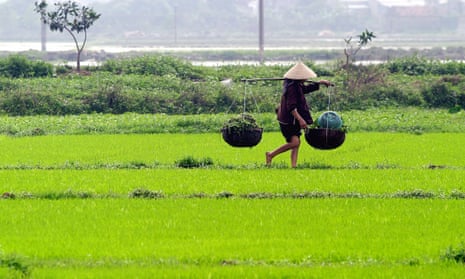1. Focus on sustainable diets
From a consumption perspective we’ve been working for several years on a project called LiveWell through which we’ve shown that diets that are good for health are also good for the environment and are affordable. In the developed world, without wanting to simplify things too much, this means reducing meat consumption and eating more plant based foods. We’re starting to see this message gain more traction. In the UK, we have a plant-based coalition of corporate, NGO and academic partners led by Alpro and supported by WWF that aims to raise awareness of sustainable diets and the benefits of plant-based eating. Nick Hughes, food sustainability advisor, WWF-UK, London, UK.
2. Integrate climate change and nutrition policies
Climate change and nutrition need to have an aligned agenda. We know crop prices will increase (it has been predicted that climate change will result in additional prices increase of 5 -25% for important agriculture crops like maize, wheat and soybeans), we also know that food quality is and will continue to be affected, so collaboration is called for to take a number of factors more seriously such as seasonality, effects of diet on greenhouse emissions, and rapid urbanisation (to name a mere few). While climate change needs to be built into national policies on the global stage, we need to work in countries and lead on the formation of nutrition alliances to identify opportunities for action. Dominic Schofield, president, GAIN Canada, Ottawa, Canada. @dschofieldGAIN
3. Empower women
Small scale farmers produce about 80% of the food in Africa and the majority of small scale farmers in sub-Saharan Africa are women. Unfortunately women are most affected by climate change damage. Women farmers often use agro-ecological type of farming which involve climate-smart practices. So empowerment of women should be seen as one intervention to address climate change. Anna Lartey, director of nutrition, Food and Agriculture Organisation of the United Nations, Rome, Italy.
4. Listen to indigenous communities
Here at IFAD we believe it’s also important to remember the value of indigenous knowledge related to climate change adaptation. This includes identification of under-utilised varieties (often now known only by elderly members of indigenous communities) as well as varieties that have higher micronutrient values and that, with change in climate, have the potential to be grown at higher altitudes. Seán Kennedy, senior technical specialist on public health and nutrition,International Fund for Agricultural Development (IFAD), Rome, Italy. @IFADnews
5. Fix our broken food systems
One third of food is lost/wasted before it makes it to the table. I think we do talk about these issues and they are reflected in the Sustainable Development Goals, but I think we have to stop talking about them as separate issues. Quite frankly, if we are going to build resilient food systems that meet food and nutrition needs, we must fix what is currently broken and then fill the gap, versus simply saying we have to produce more to feed more across the board. The latter is a recipe for disaster. Nabeeha M. Kazi, president and CEO of Humanitas Global and chair of the Community for Zero Hunger, Washington, DC. @nabeehakazi
6. Don’t forget the economic case
We have to make the economic case. Disasters cost the global economy $38 trillion between 1980 and 2012. Some 87% of these reported disasters (18,200 events), 74% of losses (US$2,800 billion) and 61% of lives lost (1.4 million in total) were caused by weather extremes.
Compare that with WFP’s Cost of Hunger study results which show that 1 dollar invested in nutrition yields 16 times the benefit. With that return on investment, it’s clear that nutrition and food security need to be priority investment areas for climate finance. Richard Choularton, chief, climate and disaster risk reduction programmes,World Food Programme (WFP), Stowe, USA. @rchoularton
7. Ensure the Paris Agreement accelerates progress
The Paris Agreement needs to accelerate efforts to bolster local, national and global capacity to manage the impacts of climate extremes and slow on-set climate change through comprehensive risk management approaches. This includes strengthening local and national disaster management capacities to prepare for, respond to, and recover from climate disasters. Richard Choularton, chief, climate and disaster risk reduction programmes,World Food Programme (WFP), Stowe, USA. @rchoularton
8. We need to get better at producing and sharing food
We need to stop calling all the time for yield increase. We know that sustainable agri-models like agro-ecology are able to feed the world. Agro-ecology - maintained by two billion farmers - is based on local knowledge and know-hows and land. It is one of the most reliable solutions to ensure food and nutrition security for all. It also contributes to improving smallholders farmers’ yield and income, developing a fossil-free, independent and sustainable agriculture, improving farmers’ resilience to climate change and meeting the challenges of climate adaptation and mitigation. Peggy Pascal, food security advocacy officer, Action Against Hunger, Paris, France. @PascalPeggy
9. Encourage more collaboration
Collaboration is certainly necessary, but there is not enough of it. There seems to be increasing acknowledgement and dialogue among the academic and technical communities about the interplay between climate change, food security, nutrition and gender, but this is less evident on the ground in programmatic design. I think that much of what is happening is reactive. Dominic Schofield
Real the full Q&A here.
Join our community of development professionals and humanitarians. Follow@GuardianGDP on Twitter.

Comments (…)
Sign in or create your Guardian account to join the discussion